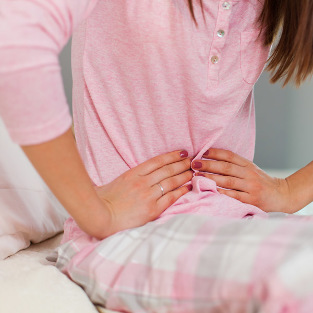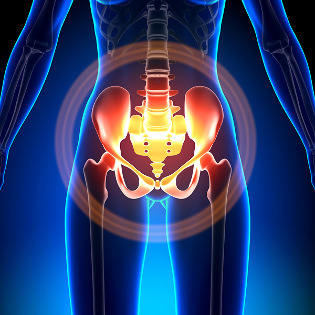Quite frequently diagnosed in medical practice during the last period, it has become a varicose vein pelvic, and meets in men and in women. However, statistics indicate that women are facing this problem most often of the opposite sex. The varicose veins of the small pelvis exposed to all age groups of women, but with the increase of the age proportional to the growth and the risk of this pathology. Of childbearing age of the varices of the vessels of the pelvis can be detected in 15% to 20% of women in period of menopause, it is diagnosed in 75 to 80% of the patients. In men, the first symptoms of varicose veins in the pelvic region, most often manifested in the range of 12 to 30 years.

THE REASONS OF The APPEARANCE OF VARICOSE veins of the PELVIC region AND THE CHARACTERISTICS OF ITS DEVELOPMENT, IN WOMEN AND MEN
The development of this disease contributes to a number of reasons. Some of them depend on the inheritance and the general state of health, and others are the consequence of a mode of life and habits. The factors causing the appearance of varicose veins pelvic, are:
- pathological dilation of the veins of the rectum and of the lower limbs;
- a hereditary predisposition;
- congenital weakness of the connective tissue and the venous wall;
- the development of tumors, tumors and hernias of the genito-urinary system;
- pelvic inflammatory disease in the chronic form;
- a sedentary lifestyle and static sports;
- a physical activity;
- forced prolonged sitting or standing position;
- the absence of a sexual life regular;
- frequent breakdowns and the lack of sleep;
- poor nutrition and overweight;
- bad habits.
Depending on the sex above list is complemented by other factors. For example, men have a such a factor may become an irregular feature of the structure of vessels and genitals. This condition is known as varicocele – the veins of the spermatic cord. Given the characteristics of the male anatomy, we can say that the more the disease is localized on the left side.
The characteristics of development of varicose veins of the pelvic region in women (the so-called female varicocele) depends on the presence of risk factors:
- and inflammatory gynecological diseases;
- mechanical compression of veins enlarged uterus;
- of sexual disorders (discomfort during sex, and anorgasmia);
- rich and multiple pregnancy;
- many and heavy labour;
- the hormonal change of the background;
- hormone replacement therapy and contraception.
It is to be noted that, despite the greater prevalence, the varicose vein pelvic poorly studied, and may be there are still reasons for its appearance.
VARICOSE VEINS in THE PELVIS, SYMPTOMS, AND THEIR CHARACTERISTICS, WOMEN AND MEN
The signs of varicose veins of the pelvic region in the early stages of development of the disease does not manifest. In male patients, it has symptoms that are the most often can be detected only by using techniques of palpation, ultrasound, functional and physical of the survey. Only when the degree of the defeat of the veins strongly raised, varicose veins can manifest itself by the deformation of the sexual organ and severe pain, even at rest.

In patients of both sexes of the pain during the varicose veins of the small pelvis begin to be observed as the evolution of pathological changes in the blood vessels and the deterioration of the flow of blood. They are located in the lower abdomen and the variation of the intensity, most patients note aching and pulling pain, giving the area sacro-lumbar area. They occur or become more pronounced when walking, after extensive static and dynamic.
When the varicose veins of the small pelvis in women, the symptoms are more pronounced than among the men:
- the pain attacks in the lower abdomen apply to the area of the crotch and strengthen, usually after a long stay in a standing or seated position; in the first days of menstruation; after cooling;
- unpleasant sensations in the genital organs and the pelvis during sexual intercourse and after a certain time after him.
- expressed premenstrual syndrome;
- the failure of the menstrual cycle (dysmenorrhea): increased duration and profusion of the menstruation;
- the secretion of the secretion of the vulva.
- venous of nodules in the area of the crotch;
- the sensitivity of the area of the perineum;
- the dysfunction of urination.
VARICOSE VEINS OF THE PELVIC REGION DURING PREGNANCY
The pregnancy is an indicator of the state of health of the woman. Many diseases, benign, asymptomatic, appear in the period of gestation of the fetus.
During pregnancy, the rapid growth of the uterus takes up more and more space in the basin. At the end of the third trimester of pregnancy, it reaches the maximum size and compresses the organs pinch vessels venous. Their wall, due to the decrease of the tonicity of the uterus, this period is much lower than usual. This physiological process adversely affect the health, and the pregnancy may be complicated by a rupture of the varicose veins, bleeding. And in the post-partum anemia and painful sensations, which can lead to problems with the veins.
During growth of the fetus, the blood flow of the uterus is increased to about 15 to 20 times, and valves, machine vascular cavity of the uterus is not always the one to get. The breach occurs a flow of blood, causing venous stasis and inflammatory processes. The blood circulation takes place in a roundabout way, which combines the weakness of the small vessels of the pelvic organs. This leads to the excess blood, and, in consequence, is manifested varicose veins pelvic. It is not excluded that after delivery, you can occur an inverse process, and the disease will go away.
Because of the violation of blood circulation in the varicose veins of the small pelvis results in a lack of oxygen to the child. Develops hypoxia of the foetus, sometimes, it serves as the pretext for a caesarean section.
During pregnancy, it is particularly important not to confuse the varicose veins of the uterus and small pelvis. To establish with certainty the disease is not only an investigation, based on methods with a high level of capacity for diagnosis: ultrasound (ULTRASONOGRAPHY), computed tomography (CT), magnetic resonance imaging (MRI). In this period of the life of a woman is given preference to ULTRASONOGRAPHY and MRI, because CT involves radiation exposure. MRI is absolutely safe, but it is not recommended to do so in the first quarter. The indications to the completion of an MRI when the varicose veins pelvic are the results of the ULTRASOUND.
During pregnancy to treat varicose veins of the small pelvis, you can use the methods that the conservative treatment. In order to completely get rid of the disease will possible after the birth. In a lot of critical situations have recourse to surgical intervention. Then use of minimally invasive methods – rf laser coagulation.
During a treatment without surgery, all the recommendations apply principally to the adjustment of the modes of life:
- increase physical activity. Exercise hiking at least two hours per day, compulsory the possibility to have a rest;
- excluding the lifting of heavy objects;
- you need to follow a diet consisting of foods rich in fibre (cereals, berries and fruits, vegetables) and are rich in healthy fats;
- take a shower is to welcome you to the pool
- since the second quarter of pregnancy, don't forget to wear a designated view of knitting or prenatal jockstrap;
- it is better to sleep on the side with a little bit optimistic of the feet;
- exercise of the respiratory tract and gymnastics, medical.
When there is an imminent threat of premature birth, the treatment is carried out permanently, under the auspices of a medical staff.
THE TREATMENT OF VARICOSE veins of the PELVIC region: The APPLICATION OF MEDICINES AND THERAPEUTIC EXERCISES
When the varicose veins of the small pelvis treatment consists of therapy with several drugs, and gyms at the exercises.
The use of medication is essential in the acute period of the disease. The main active ingredients are the following: diosmin, hesperidin, troxérutine, pentoxifylline. Vitamins and pills containing the fruit juice, extracts and vegetable oils will also give a slight improvement of the condition of the patient.
Pregnant women doctors try to allocate resources (in the varicose veins pelvic) exclusively based on natural ingredients: extract of horse chestnut, green tea extract, vitamins, oils, etc., This is to say, those medicines, which the least possible side effects. Often, the attending physician for the treatment of l', gives you the direction of physiotherapy or gymnastics, medical.
The gymnastic exercises when the varicose veins pelvic have a broad spectrum of action. They are the main treatment, which has both prevention. Exercises that use the back muscles, peritoneum, pelvis, and hips for a positive impact on the improvement of the blood circulation. Given the possible intensity level of the load, the characteristics of the state of health, employment, at work and at home, you can choose the right set of the year.
Exercises for the home may include the next series:
- the activity "Cycling": the rotation of the feet, lying on the back. 15-20 approaches;
- a "pull-up tribes": let's raise within the knee attachment of the sock to the top, we set this position for a few seconds. 10 approaches on each leg;
- exercise "Scissors": in the lying position on the back, keep the hands along the body, legs straight, socks stretch himself, to turn through the feet. 15 approaches;
- the year of the "spark Plug": the head, neck and shoulders are on the ground, the body is in need of the fix to the vertical, the back, you can hold hands, perform 5 to 7 minutes.
- an exercise on the flexibility of the back: the bracket must be on the palms and knees, first bend, and then straighten the back. 10 approaches.
At work, for example, you can perform the next series of exercises:
- exhort and straighten the fingers of the feet;
- a circular of the rotation of the feet in sitting position, 10 times;
- alternate transfer of body weight on one leg, sometimes on the other.
In the early stages of the disease to complete the treatment of varicose veins of the pelvic region can be of folk remedies. They include the adoption tonics valves, the consumption of anti-inflammatory drugs, infusions, and the promotion of hematopoiesis decoctions.
Most of the tools easy to prepare at home. Preferences in the treatment of a given disease: fruits and flowers of the horse chestnut, birch chaga, roots of dandelion, chamomile flowers.
A special place in the treatment takes prevention:
- respect for a healthy lifestyle (stopping smoking and alcohol);
- diet diet (eat smaller portions, 5 times a day at regular intervals);
- the optimal ratio of costs and leisure;
- the sexual life after varicose veins of the pelvic region should be moderate;
- a regular monitoring of indicators of blood;
- visit phlebologist.
After the healing of the disease, the patient is to celebrate the improvement is not only physical, but psychoemotional state.





































